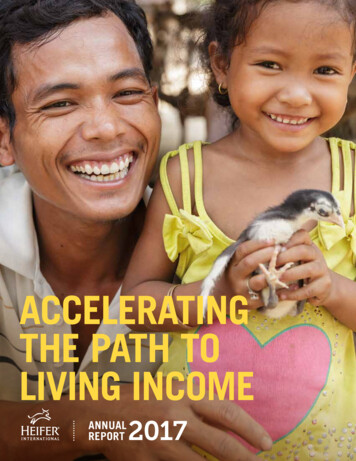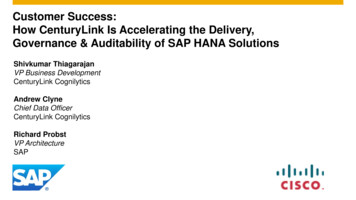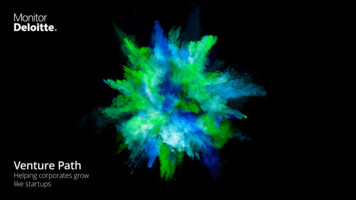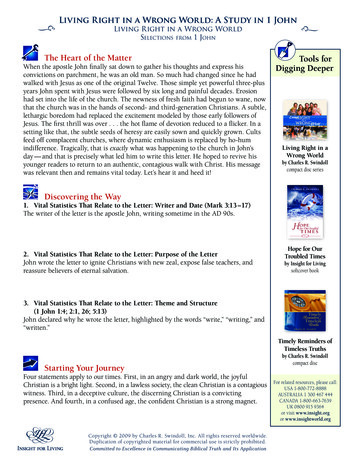
Transcription
ACCELERATINGTHE PATH TOLIVING INCOMEANNUALREPORT2017
TABLE OF CONTENTSSustainable developmentis the pathway to the futurewe want for all. It offersa framework to generateeconomic growth, achieve5Letter fromthe CEO7Our Mission8Our Worksocial justice, exercise10Progress TowardLiving Incomeenvironmental stewardship12Evidenceof Progressand strengthen governance.24StrategicPartnershipsBAN KI-MOONFormer Secretary Generalof the United Nations28Leadership30Financials
Letter From the President & CEOThe world has witnessed a turbulentyear. Millions of people experiencedthe wrath of natural disasters, froma string of hurricanes to earthquakes,mudslides, drought and severe flooding.The farmers we work alongside were not immune.Monsoon flooding in Nepal extended into India andBangladesh, wiping out farmland and washing awaycrops and livestock. Torrential rain and hurricaneforce winds pounded the northern coast of Haitiand devastated communities here at home. Couplethe unusual weather patterns with potentiallydevastating policy changes, and we stand to vastlyincrease the population of the most vulnerable.Yet, this only strengthens our resolve to buildresilience and create new value in the communitieswhere we work to help farmers generate incometo support their families. We are combiningour values-based holistic community developmentwith inclusive market development to createan exponential cycle of rural economic growth —providing the momentum needed to help familiesmove out of poverty.In the past year, we have seen a growing evidencebase of sustainable change in livelihoods andresilience among households and communities,which you’ll see reflected in this report.We see our work as an important part of the biggerpicture in achieving the United Nation’s SustainableDevelopment Goals of zero hunger and povertyby 2030. And our commitment deepens to continueour work of empowering farmers, strengtheningtheir connections and building resilience to movethem toward a prosperous future.Our tLivestockTrainingOur innovative waysto strengthenrural economies Connectionto marketsStrengtheningagro enterpriseAccess to capitaland partnershipsWill help achieve:Thank you for standing in solidarity with us aswe continue to accelerate the path to living incomefor farmers worldwide.Yours for a better world,Pierre FerrariHeifer International Annual Report 20175
Our MissionTHE MISSION OF HEIFER INTERNATIONAL ISTO END HUNGER AND POVERTY WHILE CARINGFOR THE EARTH. To achieve that mission, we have developedstrategies to increase our impact and help more people create trulyresilient, sustainable lives. Each strategy has built upon the last.TWO YEARS AGO, WE ADVANCED THAT WORK AGAIN:CREATING A GOAL TO CLOSE THE GAP BETWEENPOVERTY AND A LIVING INCOME FOR THE SMALLSCALE FARMING FAMILIES WHO PARTICIPATE INOUR PROJECTS. We knew we needed to help farmers analyzeand maximize what income they can earn from their farmingactivities, while providing tools, training and support.NOW, WE ARE ACCELERATING THE GOAL TOPARTNER WITH EXTREMELY POOR SMALL-SCALEFARMERS WHILE ADVANCING WORK IN INCLUSIVEMARKET SYSTEMS WITH A STRONG VALUES-BASEAT THE CORE. By helping farmers access formal marketsand capital, we can provide opportunities that make millionsof farming families achieve the growth that moves them outof poverty to a living income. We believe this work will alsohelp the entire global development community move forwardon the path to zero hunger and zero extreme poverty by 2030.Heifer International Annual Report 20177
Our WorkOur WorkIN FISCAL YEAR 2017WE ASSISTED 2.1 MILLIONFAMILIES EITHER DIRECTLYOR INDIRECTLY. MORETHAN 107,000 FAMILIESWERE PART OF 33 NEWPROJECTS INITIATED.Passing on the Gift isthe hallmark of our approach.This practice, at minimum,doubles the impact of theoriginal gift, transforminga once impoverished familyinto full participants.PORTFOLIO AT A GLANCEOUR WORK AT HOMENumber of families assisted sinceHeifer began operations in 1944:The following is a snapshot of how Heifer USA is helping Arkansas farmerssustain higher incomes, as well as support the local food movement,keeping wealth in communities.32.3 MILLIONFY17TOTALNEW197TOTAL NUMBEROF PROJECTS332,173,325INCREMENTAL FAMILIESASSISTED107,925PROJECTSPLANNED NUMBER OFFAMILIES IN NEW PROJECTSPROFILE AND RESULTSGrass Roots Farmers’ CooperativeINCORPORATED IN 2014FARMERSMEMBERSHIPSPRODUCT STANDARDS13ANNUAL REVENUEIMPACT TO FARMERS 493%GMOAntibioticsGrowth-hormones 83,000 ( 416%)in average gross revenues from meatsales up from 16,100 in 2014.2016Pastured chickenGrass-fed beef 1,402,880Forested/pastured pork2,000 lbs2014WHERE WE WORKDONATIONS TO COMMUNITIESof chicken and pork to food pantries in the Fayetteville, Ark. area. 236,430New South Produce CooperativeINCORPORATED IN SMEXICONICARAGUAPERU*UNITED IAUGANDAZAMBIAZIMBABWEHeifer International Annual Report 2017ANNUAL REVENUEIMPACT TO FARMERS 295%full2016DONATIONS TO COMMUNITIES 377,320Certified OrganicassociateCertified NaturallyGrown 11,100 in average gross revenuesfrom produce sales to New SouthProduce in 2016; the percentageof farmers impacted has increasedby 500 percent.6,427 lbs2014of fresh produce to the ArkansasHunger Relief Alliance. 95,5402014-2017*Transitioning fromdirect Heifer management8816PRODUCT STANDARDS2034678810new farmers in Arkansasco-ops; 110 additional newfarmers outside Co-opsfull time equivalent off-farm jobsfarmers attendingtrainingfarmers receivinggrantsnew transactionalpartners selling toNew South ProduceHeifer International Annual Report 20179
Progress TowardLiving IncomeProgress Toward Living IncomeBIHAR, INDIALIVING INCOME REFLECTS THE TOTAL INCOMENEEDED TO LIVE A DIGNIFIED LIFE — ONE WITHADEQUATE, NUTRITIOUS FOOD, ACCESSTO RESOURCES, EMPOWERMENT, AND CHILDRENEDUCATED, HEALTH CARE AND FUNDS FOREMERGENCIES. THIS YEAR, WE DEVELOPED22 BENCHMARKS IN 15 COUNTRIES, ANDALL PROJECTS ARE NOW REQUIRED TO BUILDTHE LIVING INCOME BENCHMARK AND ANALYSISINTO PROJECT DESIGN.Below are insights from Bihar,India, where living incomebenchmarks were applied inproject adaptation. Other examplesof benchmarks and actual incomeare also shown.CASESTUDYBased on market analysis andvalue chain gaps, the followingare examples of value-additionactivities considered forimplementation that willhelp close the income gapbetween current incomeand living income.Good NutritionHydroponic FodderIncrease animal-source foodconsumption to improve nutritionof women and children sincemalnutrition and stunting rank highin India, thus influencing behaviorchange in the community.Implement a community-managedfodder strategy, grow hydroponicfodder in large scale, and sellto the community at nominalprices to address shortages inthe lean season.YouthRisk FundBuild skills among local youth,primarily girls, to supportmanagement and marketingof local produce, and forwardlinkages in the value chainto ensure steady growth in thecooperatives and reduce migration.Introduce a community-managedrisk fund for livestock.Bihar Context: 13th largest state by area 3rd largest population,leading agriculture state 40% population belownational poverty line 58% populationBihar, IndiaComparison: Living Income Benchmark,World Bank Poverty Line, Actual incomeCLOSING THE INCOME GAPyounger than 25 USDBihar SocioeconomicDevelopment Project: 24,000 women smallholderExamples of Living Income analysis from other countriesBENCHMARK VS ACTUAL FY17 NET INCOMEfarmers from minoritycommunities/castes Women’s self-help groups,NET INCOME 2017WORLD BANK EXTREME POVERTY LINELIVING INCOME BENCHMARKproducer cooperatives,and value chainsGUATEMALA Total Project Cost: 4.89 millionNET INCOME 2017 January 2016 start date 1.19 /dayWORLD BANK POVERTY LINE Primary project interventions: 1.90/dayGOATSLIVING INCOME BENCHMARKDAIRYSAPLINGS123HONDURASRWANDA 4.52 3.11 1.90 6.08VEGETABLES04 3.37 2.13 1.90Western regionYear 3 of implementationEast & WestYear 3 of implementation 3.99/day0 2.28 1.90Northern regionYear 2 of implementation1234567FODDER SEEDS10Heifer International Annual Report 2017Heifer International Annual Report 201711
Evidenceof ProgressEvidence of ProgressSUSTAINABLEINCOMEEACH YEAR WE MONITOR PROGRESS ON KEYINDICATORS IN A CROSS-SECTION OF PROJECTS.PRESENTED HERE IS DATA THAT SPEAKS TOOUR CORE WORK IN COMMUNITY DEVELOPMENTAND INTEGRATED LIVESTOCK AGRICULTURE,WHICH IS FOUNDATIONAL TO OUR SUCCESSIN ENDING HUNGER AND POVERTY AND CARINGFOR THE EARTH. WITHOUT THIS WORK, LIVINGINCOMES WOULD BE OUT OF REACH.Household Real Annual Net IncomeSAMPLE OF PROJECTS2015 USD2016 REAL USDBOLIVIA 956.98fruits & vegetablesBOLIVIA 767.86vegetables, grains & honeyBOLIVIA 4,325.53fruits & vegetablesGUATEMALA 4,763.30coffee & beekeepingMALAWI 2,590.70dairyVIETNAM 3,175.25beef cattleVIETNAM 3,099.18beef cattleVIETNAM 3,939.44dairy cattleZIMBABWE 1,238.58goat 012 1000 2000Heifer International Annual Report 2017 3000 4000 5000Reviewing annualhousehold income yearover year in a sampleof projects helps ussee changes over timein specific communities.Evaluation and casestudy reporting alsodemonstrates increasesin income resultingfrom improved businessskills and strategieswith increasedmarket engagement.In 2017, we transitionedto reporting on net incomefrom gross income tomore accurately reflectdisposable income.The change in approachis required for acomparison to the livingincome benchmark.SUPPORTING EVIDENCEA Malawi community wherepost-project reporting wasfinalized in fiscal year 2017demonstrates economic benefitsthat are sustained and continueto grow three years post-project,taking communities beyondliving income.The analysis included asocial network analysis anddemonstrated that our projecthad strengthened social capitalthroughout the community with“relational spillover” effects,including knowledge sharing,social safety net support andother benefits. These spillovereffects also have a significanteconomic value.Farmers’ average income 4.60USD/day 2.78USD/day20153 yearsafter project 1.09USD/day2012Project end2009Project inceptionInformationNetwork62% rely on Heifer farmersand Comunity AnimalHealth Workers for newinformation on cropand/or livestock production.For every 1% increasein a Heifer farmer’sincome, the income ofpeople in their networkgrew by 0.78%.AssociationFor every one Heifer farmer,5.3 people (ratio of 1:5) benefitedfrom an association with thatHeifer farmer.80%of the respondentsadopted new crop practicesdue to a relationship witha Heifer farmer.Heifer International Annual Report 201713
Evidence of ProgressFOODSECURITYWe assess food securityby considering dietarydiversity scores andavailability of food usingmonths of adequatefood provision. Dietarydiversity captures ahousehold’s access to aquality diet. The dietarydiversity score capturesthe number of foodgroups consumed ineach period — 12 beingthe maximum available,and above six consideredacceptable.Dietary Diversity ScoresSAMPLE OF PROJECTS 2015-2017201520162017BOLIVIA6.44fruits & vegetablesBOLIVIA6.03vegetables, grains & honeyBOLIVIA8.76fruits & iryNEPAL7.1goatsNEPAL7.6goatsPEROU8.6agroecology productionPERUIn Bangladesh, a project whererecipients received both microfinanceand our values-based holisiticcommunity development model,the number of vegetable-producinghouseholds increased significantlyafter intervention in 2016, from lessthan 20% of households to almost90%8.58guinea pigVIETNAM7.3beef cattleVIETNAM6.7beef cattleVIETNAM8dairy cattle024681012The Malawi Scale-Up project increased dietary diversity over two years of projectimplementation from 4 at baseline to 10.32 in 2017; improvements in dietary qualityis attributed to increased milk consumption from 44.53% at baseline to 94.3% in2017; increased milk production per cow per household; good harvest from ownproduction. Milk production reached 12.5 liters per day per cow surpassing targetof 12 liters.Nepal projects reported scores above 7 — higher than the average Nepal scoreof 6.4. Consumption of animal food sources has increased, for example, familiesconsuming meat went from 28% to 49% in 2017.Heifer International Annual Report 201715
Evidence of ProgressEvidence of ProgressMonths of adequate household foodprovision is also a widely-acceptedindicator for food security.Months of Adequate Food ProvisionSAMPLE OF PROJECTS 2015-2017201520162017Beef cattle and dairy cattle projectsBOLIVIA7.0fruits & vegetablesBOLIVIA5.0fruits & vegetablesHONDURAS7.8honeyINDIA11.2goatsINDIAin Vietnam attributed sustainedimprovements in food securityindicators to the awareness andtraining in human nutrition for healthimprovement. Increases in incomehave also enhanced the opportunitiesand reduce the vulnerability duringthe “thin months,” or hunger thatoccurs seasonally.SUPPORTING EVIDENCEEvaluation results in Bangladeshshow that an increase in incomecan directly impact food securityand the diversity of diets eatenby project participants. In this actionresearch study in Bangladesh,we supplemented our model withmicrofinance. We evaluated theimpact difference in groups whoreceived our Values-Based HolisticCommunity Development witha reference group that receivedonly microfinance.Average IncomeHeifer participants remarkablyincreased incomes, improvedtheir vegetable production,poultry farming, cattlefattening, improved sanitation,hygienic and nutritionalknowledge, planting of fodderand fruit trees from the baseyear. However, the rate ofincrease of average income forHeifer group(from 63.98 to 90.52) is appreciably higherthanReference group (from 82.70 to 90.63).11.6goatsFruits and vegetables projects inMALAWI11.0dairyMALAWI9.0goats & chickenNEPALVegetablesBolivia show a decrease in both foodsecurity indicators which is attributedto severe drought in the project areas,reducing crop productivity.The numbers of vegetable producinghouseholds under Heifer groupsincreased significantly afterintervention — from less than20% of households to almost 90%.11.5goatsNEPAL10.8goatsPERU11.5agroecology productionPERUDrinking WaterDiversificationAccess to safe drinking waterwent from 79.87% to 98.60%.Food consumption diversification and nutrition intake increased among Heiferparticipants. Per day, the increases were:11.0guinea pig0.100 kgVEGETABLESVIETNAM12.0beef cattleVIETNAMMEAT12.0beef cattleVIETNAM0246810120.010 to 0.020 kg0.033EGG12.0dairy cattle19 %DAL/BEANMILKFRUITHeifer International Annual Report 20170.0880.022 to 0.045 kgFISH0.012 to 0.018 kg0.016 to 0.034 liter0.009 to 0.024 kg0160.187 kg0.050.10.150.2Heifer International Annual Report 201717
Evidence of ProgressENVIRONMENTALPROTECTIONIn areas of the world whereagricultural productivity isalready low and the meansof coping with adverseevents are limited, climatechange is expected toreduce productivity to evenlower levels. To stabilizeoutput and income,production systems mustbecome more resilient.Climate Smart Agriculture PracticesSAMPLE OF PROJECTS oneyMALAWI99%dairyMALAWI39%goats, chickenSENEGALClimate-smart agriculture istackling this by sustainablyincreasing agricultural productivityand incomes; adapting and buildingresilience to climate change;and reducing and/or removinggreenhouse gas emissions,where possible.We have seen a large increasein the adoption of climate-smartagriculture across the portfolio.On average, 75.3 percentof project participants haveadopted climate-smartagricultural practices duringfiscal year 2017, an improvementover fiscal year 2016 thatreported 60.1 percent adoption. 25%15%biogasVIETNAM83%beef cattleVIETNAM75%beef cattleVIETNAM80%dairy cattle0On average, across the portfolioof projects reporting, 75.3% of projectparticipants have adopted climate-smartagricultural practices compared to60.1% last year.406080100In Ecuador, a project working with solar energy reported an increase from 62% to69% during fiscal year 2017.Facing drought, farmers in the Mekong Delta in Vietnam were motivated toadopt climate-smart agriculture practices including water harvesting, integratedfarming systems, and drinking systems for dairy cows. Significant improvementwas reported, from less than 20% in 2016 to around 80% in 2017.SUPPORTING EVIDENCESoil management and nutrientimprovement is a sub-classificationof climate-smart agriculturalpractices. On average, 73.8 percentof project participants adopted soilmanagement practices during fiscalyear 2017. This is an improvementfrom last year that was reportedat 67 percent.20Beef Cattle ProjectFood Security ProjectA beef cattle project inVietnam reported that99% of the participantsadopted soil managementpractices by the endof the project in 2017.An environmental conservationand food security projectin Ecuador reported that 100%of the project householdsadopted soil managementpractices at the end of theproject in 2017.Swine ProjectFinal evaluation of a Philippines swineproject showed increased soil managementpractices from 53% at baseline to 85% atthe end of the project.100%Heifer International Annual Report 201719
Evidence of ProgressEvidence of ProgressEDUCATIONAND WOMEN’SEMPOWERMENTWomen Decision-Making Power Over Productive AssetsSAMPLE OF AL56%goatsVIETNAM86%beef cattleVIETNAM85%beef cattleVIETNAM70%dairy cattle020406080100Nepal: after 18 months, intervention causes a statisticallysignificant increase in the index of women’s financial inclusionand an increase in empowerment among direct beneficiariesGender equity andwomen’s empowermentremain core to our work.We strive to ensure thatwomen gain decisionmaking power where itis absent and that theydevelop skills to take onleadership roles at groupand community levels.Our work seeks to incorporatecooperatives, enterprises andvalue chain activities, therebyensuring continued women’sempowerment and the fullinclusion of women in thebenefits of market development.SUPPORTING EVIDENCEIn East Africa, women’sparticipation in decision-makingabout morning and evening milkproceeds, participation in the saleof livestock and land cultivationdecisions increased in Kenya,Uganda and Tanzania. Resultssuggest that increasing milksupply to the hub will havepositive and significant effectson gender participation.Gender equality increasessignificantly if the productionof milk per cow increased.Women controlling proceeds from morning milkUGANDATANZANIATrainingThis indirect effect is not present wherethe training is not included, suggesting thatthe values-based training is critical for achievinga broader impact at lower cost.4.3%20Assets and incomeCompared to women in the control group, womenwho participated in the program are 4.3% morelikely to own productive assets and 4.6% more likelyto have some control over use of income.Heifer International Annual Report 201748%12%54%14%UGANDA14% 24%38%15% 28%Women controlling productive assetsSUPPORTING EVIDENCEIn Nepal, preliminary findingsfrom a randomized controlledtrial in five districts of Nepalaffected by the April 25, 2015,7.8-magnitude earthquakedemonstrate that, despitethe earthquake, our programis empowering women ages20 to 40 and connecting themto financial markets.14%KENYAKENYACommunitySubstantial indirect effects were also observed.Those who live in the same community as directbeneficiaries but who were not targeted alsoexperienced statistically significant increases infinancial inclusion and empowerment in keepingwith those seen in directly targeted beneficiaries.42%Women’s participation in proceedsfrom sale of livestock and land cultivationTANZANIAEvaluations reporting in fiscalyear 2017 add to the evidencebase for increasing gender equityand women’s empowerment.31%KENYAUGANDA28%45.2%23% 25.8%TANZANIA4267% 68.9%In Tanzania the proportionof women controllingproceeds from morningmilk rose by 42%.Heifer International Annual Report 201721
Evidence of ProgressSOCIAL CAPITALParticipation in Community-Based OrganizationsSAMPLE OF PROJECTS201520162017BOLIVIA64%fruits & goatsNEPAL64%goatsVIETNAM59%beef cattleVIETNAMSOLIDARITY AND COOPERATIONOn average, 80 percent of projectparticipants perceived solidarity andcooperation among their communitymembers during fiscal year 2017.72%beef cattleVIETNAM66%dairy cattle020406080100The graph shows that all the projects result in increased households’participation in community-based organizations. The median result is 70.8%of project members participating. However, in a few instances the projectsachieve 100% of participation.The Malawi dairy project reported that 100% of the participants are engaged incommunity-based organizations in 2017. Households recognized that belongingto milk bulking groups as well as other community groups provide supportas part of their social safety net.8022Heifer International Annual Report 2017Social capital is the foundationof our Values-Based HolisticCommunity Development model.It can refer to the composition andpractices of local-level institutionsand social networks that enablecollective action or to the sharednorms, values, attitudes and beliefsthat predispose people towardmutually beneficial collective action.We look at both to gauge the levelof participation or engagementin community-based organizationsas a measure.of project participantsperceived solidarity andcooperation among theircommunity membersacross the portfolioof projects reporting.This can be explained by the groupand hub approach along withour 12 Cornerstones for Justand Sustainable Developmentthat are used as guiding principlesto community approach.In Vietnam, pre-cooperativeand cooperative training are someof the activities that emphasizedthe importance of a collective groupin improving community spiritand entrepreneurship.Training on gender equity,which raises awarenessof women’s roles in familiesand the importance of shareddecision making, led toprojects reporting that theaverage rate at which womenheld decision-making powerover productive assets was66%across the portfolioof projects reporting.
StrategicPartnershipsStrong alliances arekey to advancing ourmission of endinghunger and poverty.We endeavor todevelop partnershipswith values-drivenorganizations thatalign with our mission,values, strategy andholistic communitydevelopment approach.We prioritizerelationships thathave the potential tostrengthen inclusivelocal economies andto connect small-scalefarmers to formalizedvalue chains andstrong demand-drivenmarkets, allowing usto have exponentialimpact for thefarming families wework alongside. Thefollowing is a samplingof those we initiatedagreements with orstarted new projects orfundraising programswith in 2017.24Heifer International Annual Report 2017Strategic PartnershipsBLOMMER CHOCOLATE COMPANYThe Ecuadorian Equation: A Future for Cocoa Farmers in the Amazonis a two-year project designed by Blommer Chocolate company, HeiferInternational and ECO-KAKAO S.A. The effort will support 2,000 cocoafarming families in the Amazon region of Ecuador, and the consortiumwill improve opportunities for rural cocoa organizations by addressingbusiness and production-capacity challenges as well as social,environmental and food security issues the families face. The projectresponds to the procurement interests of the export company, ECOKAKAO, in association with the established buyer, Blommer Chocolate.The project will also take special concern for commercial growth to bedeveloped while taking care of the fragile ecosystem of the Amazon.INTERNATIONALFLAVORS AND FRAGRANCESIFF is working with Unilever’sEnhancing Livelihoods Fundto improve the lives of smallholdervetiver farmers in the communityof Favette, Haiti. The partnership,Vetiver Together, aims tosustainably improve food security,increase yields and diversifyincome, while working to supportwomen’s empowerment andenvironmental conservation.MASTERCARD FOUNDATIONSupportWOMEN’SEMPOWERMENTAND ENVIRONMENTALCONSERVATIONin Haiti.Support2,000COCOA-FARMINGFAMILIESin the Amazonregion of Ecuador.CARGILLA partnership between CargillAnimal Nutrition and HeiferInternational will transform thelives of 471 families in Qingshen,China. Families will receive chicks,training in poultry-raising andanimal nutrition, natural resourcemanagement, go-to-marketstrategies and veterinary support.A large youth population andgrowing unemployment in Tanzaniaand Uganda led to the formationof the East Africa Youth Inclusionprogram. In partnership withMastercard Foundation, Heiferwill help 25,000 young women andmen find jobs or start businesses inTanzania and Uganda’s agriculturalsectors, including dairy, poultryand horticulture. Building on thesuccesses of the East Africa DairyDevelopment project, EAYIP willequip participants with technical,life and entrepreneurial skills;facilitate access to finance; enhancethe enabling environment foryouth to start or expand businesses;and replicate Heifer’s hub approachin profitable value chains.DEPARTMENT FOR INTERNATIONAL DEVELOPMENTTransformthe lives of471FAMILIESin China.Heifer International Malawi with financial support from the Departmentof International Development (DFID) has been implementingthe Central Region Dairy Scale-Up Project (CDSP) in Mchinji,Lilongwe and Dowa since November 2014. The project is working with5,000 families engaged in dairy farming and agribusiness to increaseincome and employment benefits, as well as to increase access to safenutritional dairy products for low-income consumers. In October 2017,DFID awarded Heifer Malawi with additional funds to ensure projectsustainability and increase project impacts until April 2018.HelpWOMEN25,000 YOUNGAND MENfind jobs or start businessesin Tanzania and Uganda.Heifer International Annual Report 201725
Strategic PartnershipsWEFARMThe Heifer-Wefarm partnership will involve about 2,000 farmersin Nakuru County in the Rift Valley region of western Kenya, andwill enable farmers without internet access to use their mobile phonesto share agricultural information vital to their livelihoods. The serviceenables the farmers to use their mobile phones to text questionsor tips to a local Wefarm number for free. The messages are instantlyposted online and then sent via text messages to selected membersof the Wefarm community, which reply with text messages.Help2,000 FARMERSin Kenya to shareagricultural informationwith their mobile phones.SWEDISH INTERNATIONAL DEVELOPMENT AGENCYA four-year, 12.6 million partnership between Heifer and the SwedishInternational Development Agency will help 30,000 Kenyan farmersincrease the quantity and improve the quality of the milk they produceas well as empower women to play a more active role in the industry.The initiative will also promote the use of environmentally friendlyproduction practices. Private sector partner Tetra Laval will contributetechnical assistance expertise to the project. The state-run New KenyaCo-operative Creameries is also helping fund the initiative.WORLD BANKA four-year, 1.2 millionpartnership between Heifer andthe Jharkhand State LivelihoodPromotion Society and financedby the World Bank, the JharkhandOpportunities for HarnessingRural Growth project (JOHAR)will support 15,000 goat farmers,5,000 pig farmers and 30,192 backyard poultry farmers across10 districts of India’s Jharkhandprovince. The partnership willfocus on improving householdlevel production of goat, pig andpoultry farming. JOHAR willincrease the target community’sadoption of Improved Animal andResources Management Practices,thereby lifting participatinghouseholds out of poverty.Support5,00030,192 POULTRYFARMERSFARMERS15,000 GOAT10 DISTRICTSPIGFARMERSaccrossin India.Help30,000 FARMERS26to increase the quantity andimprove the quality of the milkthey produce as well as empowerwomen to play a more active role.Heifer International Annual Report 2017by improving householdlevel production.
LeadershipLeadershipTHE EXECUTIVELEADERSHIP CABINETBOARD OFDIRECTORSOur Board of Directorsis comprised of18Pierre FerrariHilary HaddiganBob BloomMahendra LohaniPresident andChief Executive OfficerChief of Mission EffectivenessChief Financial OfficerSenior Vice Presidentfor ProgramsMEMBERSThe Board of Directors on a recent trip to Tanzania (not pictured include: Eduardo Stein Barillas,Daryn Dodson, Sandra Godden, Jerry Jones, Pete Kappelman, George Petty, Ashley Stoneand Arlene Withers)3FAITH-BASEDGROUPSrepresenting variousspiritual paths14Oscar CastanedaDavid NormanChristy MooreJulie WoodSenior Vice Presidentfor the Americas ProgramSenior Vice Presidentof Investment ProgramsSenior Vice Presidentof MarketingVice Presidentof Human Resourcesholding board-specificskill sets; At leastone director residesin each of theinternational programareas where Heifercarries out its work1Michelle Dusek-IzaguirreChad AveryJessica FordVice President of Marketing andResource Development OperationsGeneral CounselBoard Liaison andExecutive Office Director28Heifer International Annual Report 2017AT-LARGEDIRECTORSREPRESENTATIVEfrom the HeiferInternational Foundation’sBoard of Trustees(Chair or Vice Chair)Our Directors come from a wide range of backgroundsin the business, agriculture, academic and privatesectors. All the following directors are independentvoting members, as defined in IRS Form 990.Francine AnthonyAt-Large Directorsince 2011Nikolaus HutterAt-Large Director, Intl.since 2013Steven YungAt-Large Director, Intl.since 2015Dr. Sandra A. GoddenAt-Large Directorsince 2011Jerry JonesAt-Large Directorsince 2013Tom HadfieldAt-Large Directorsince 2016Susan GrantChairAt-Large Directorsince 2011Esther CohenFaith-based Directorsince 2013George PettyHeifer InternationalFoundation ChairAshley StoneAt-Large Directorsince 2014VacantArlene WithersAt-Large Directorsince 200
of fresh produce to the Arkansas Hunger Relief Alliance. 2014 2014 Antibiotics Grass-fed beef Certified Naturally Grown Growth-hormones Forested/pastured pork 493% 295% 83,000 2,000 lbs 6,427 lbs ( 416%)










